Page 90 of 509
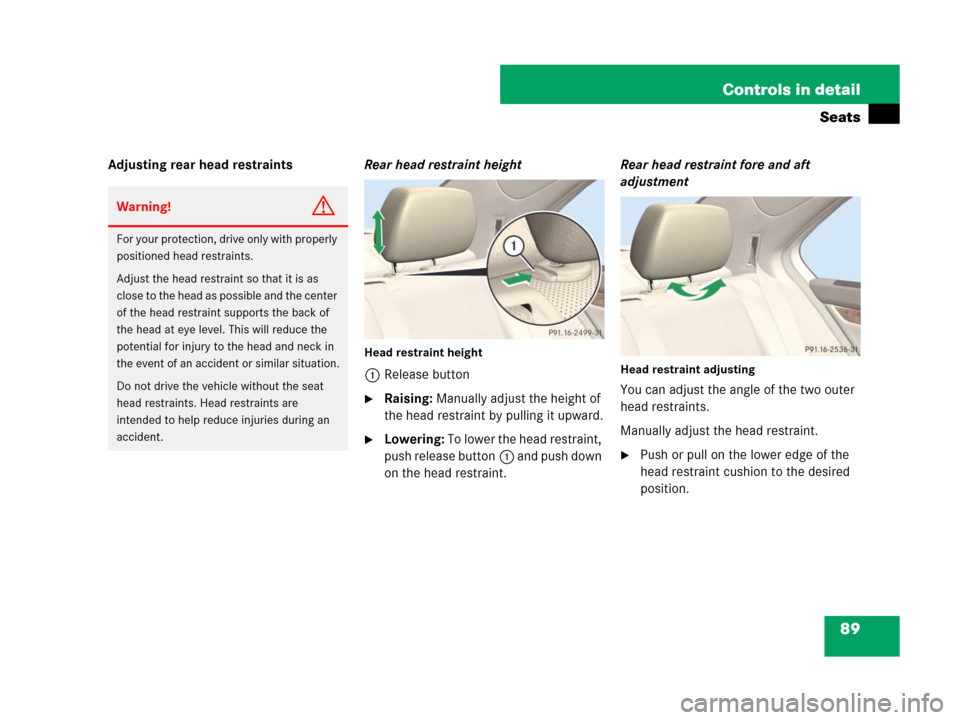
89 Controls in detail
Seats
Adjusting rear head restraintsRear head restraint height
Head restraint height
1Release button
�Raising: Manually adjust the height of
the head restraint by pulling it upward.
�Lowering: To lower the head restraint,
push release button1 and push down
on the head restraint.Rear head restraint fore and aft
adjustment
Head restraint adjusting
You can adjust the angle of the two outer
head restraints.
Manually adjust the head restraint.
�Push or pull on the lower edge of the
head restraint cushion to the desired
position.
Warning!G
For your protection, drive only with properly
positioned head restraints.
Adjust the head restraint so that it is as
close to the head as possible and the center
of the head restraint supports the back of
the head at eye level. This will reduce the
potential for injury to the head and neck in
the event of an accident or similar situation.
Do not drive the vehicle without the seat
head restraints. Head restraints are
intended to help reduce injuries during an
accident.
Page 91 of 509
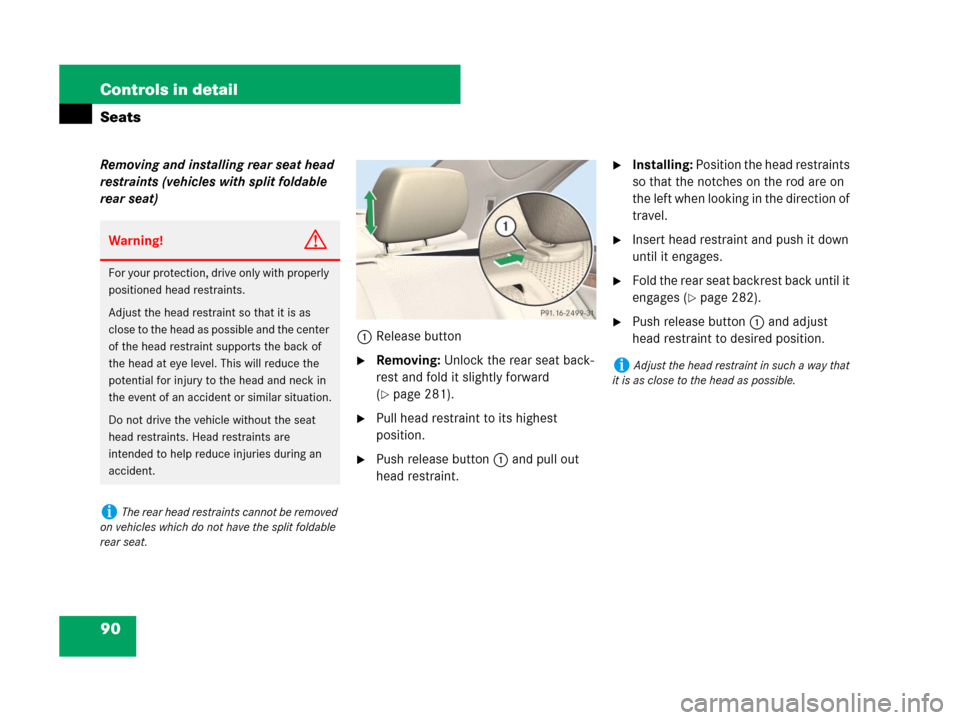
90 Controls in detail
Seats
Removing and installing rear seat head
restraints (vehicles with split foldable
rear seat)
1Release button
�Removing: Unlock the rear seat back-
rest and fold it slightly forward
(
�page 281).
�Pull head restraint to its highest
position.
�Push release button1 and pull out
head restraint.
�Installing: Position the head restraints
so that the notches on the rod are on
the left when looking in the direction of
travel.
�Insert head restraint and push it down
until it engages.
�Fold the rear seat backrest back until it
engages (
�page 282).
�Push release button1 and adjust
head restraint to desired position.
Warning!G
For your protection, drive only with properly
positioned head restraints.
Adjust the head restraint so that it is as
close to the head as possible and the center
of the head restraint supports the back of
the head at eye level. This will reduce the
potential for injury to the head and neck in
the event of an accident or similar situation.
Do not drive the vehicle without the seat
head restraints. Head restraints are
intended to help reduce injuries during an
accident.
iThe rear head restraints cannot be removed
on vehicles which do not have the split foldable
rear seat.
iAdjust the head restraint in such a way that
it is as close to the head as possible.
Page 92 of 509
91 Controls in detail
Seats
Lumbar support
The curvature of the front seats can be ad-
justed to help enhance lower back support
and seating comfort.
1Adjustment lever
�Move adjustment lever1 in direction
of arrows until you have reached a
comfortable seating position.
Seat heating*
The buttons for the front seats are located
in the center console. The red indicator
lamps on the button come on to show the
selected heating level.
1Seat heating buttonLevel
3Three indicator lamps on
(highest level)
The seat heating automatically
switches to level2 after approxi-
mately 5 minutes.
2Two indicator lamps on
The seat heating automatically
switches to level1 after approxi-
mately 10 minutes.
1One indicator lamp on
(lowest level)
The seat heating automatically
switches off after approximately
20 minutes.
offNo indicator lamp on
Page 95 of 509
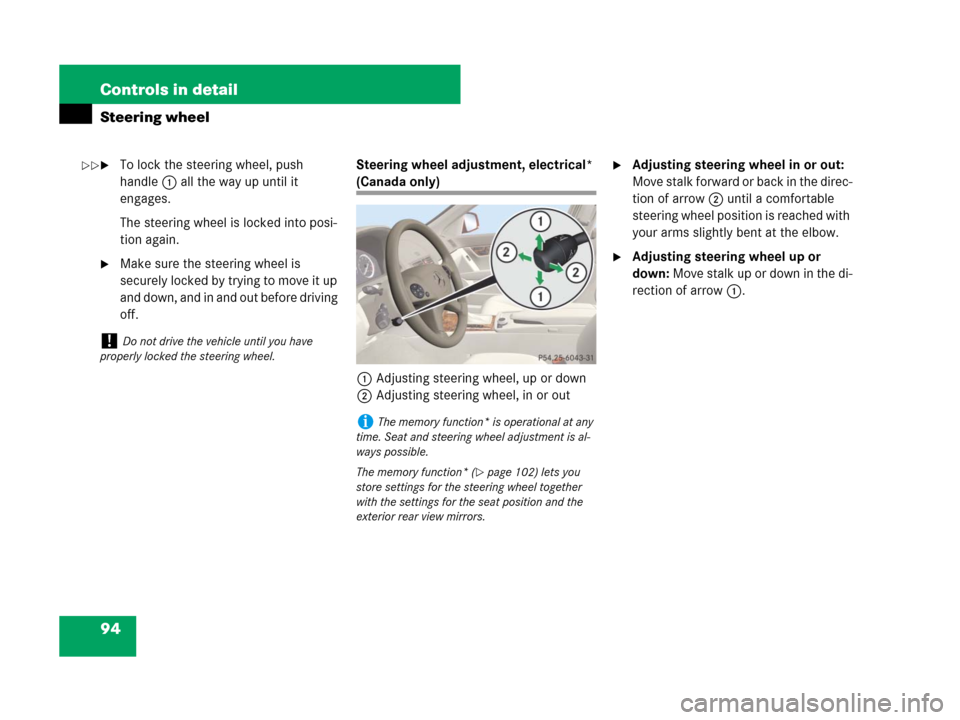
94 Controls in detail
Steering wheel
�To lock the steering wheel, push
handle1 all the way up until it
engages.
The steering wheel is locked into posi-
tion again.
�Make sure the steering wheel is
securely locked by trying to move it up
and down, and in and out before driving
off.Steering wheel adjustment, electrical*
(Canada only)
1Adjusting steering wheel, up or down
2Adjusting steering wheel, in or out
�Adjusting steering wheel in or out:
Move stalk forward or back in the direc-
tion of arrow2 until a comfortable
steering wheel position is reached with
your arms slightly bent at the elbow.
�Adjusting steering wheel up or
down: Move stalk up or down in the di-
rection of arrow1.
!Do not drive the vehicle until you have
properly locked the steering wheel.
iThe memory function* is operational at any
time. Seat and steering wheel adjustment is al-
ways possible.
The memory function* (
�page 102) lets you
store settings for the steering wheel together
with the settings for the seat position and the
exterior rear view mirrors.
��
Page 99 of 509
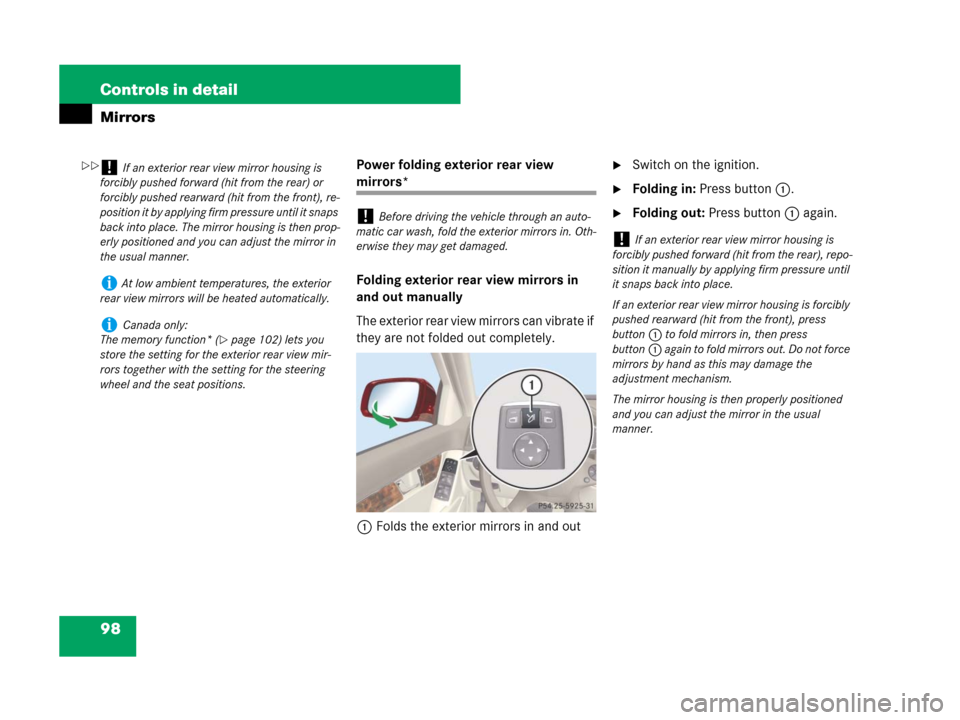
98 Controls in detail
Mirrors
Power folding exterior rear view
mirrors*
Folding exterior rear view mirrors in
and out manually
The exterior rear view mirrors can vibrate if
they are not folded out completely.
1Folds the exterior mirrors in and out
�Switch on the ignition.
�Folding in: Press button1.
�Folding out: Press button1 again.
!If an exterior rear view mirror housing is
forcibly pushed forward (hit from the rear) or
forcibly pushed rearward (hit from the front), re-
position it by applying firm pressure until it snaps
back into place. The mirror housing is then prop-
erly positioned and you can adjust the mirror in
the usual manner.
iAt low ambient temperatures, the exterior
rear view mirrors will be heated automatically.
iCanada only:
The memory function* (
�page 102) lets you
store the setting for the exterior rear view mir-
rors together with the setting for the steering
wheel and the seat positions.
!Before driving the vehicle through an auto-
matic car wash, fold the exterior mirrors in. Oth-
erwise they may get damaged.
!If an exterior rear view mirror housing is
forcibly pushed forward (hit from the rear), repo-
sition it manually by applying firm pressure until
it snaps back into place.
If an exterior rear view mirror housing is forcibly
pushed rearward (hit from the front), press
button1 to fold mirrors in, then press
button1 again to fold mirrors out. Do not force
mirrors by hand as this may damage the
adjustment mechanism.
The mirror housing is then properly positioned
and you can adjust the mirror in the usual
manner.
��
Page 103 of 509
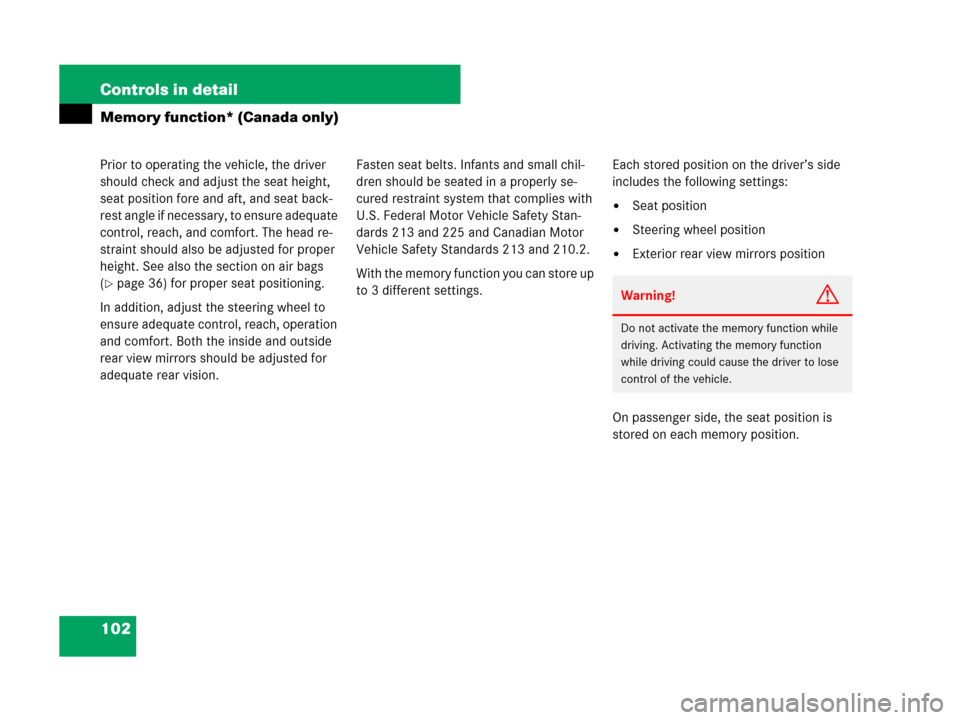
102 Controls in detail
Memory function* (Canada only)
Prior to operating the vehicle, the driver
should check and adjust the seat height,
seat position fore and aft, and seat back-
rest angle if necessary, to ensure adequate
control, reach, and comfort. The head re-
straint should also be adjusted for proper
height. See also the section on air bags
(
�page 36) for proper seat positioning.
In addition, adjust the steering wheel to
ensure adequate control, reach, operation
and comfort. Both the inside and outside
rear view mirrors should be adjusted for
adequate rear vision.Fasten seat belts. Infants and small chil-
dren should be seated in a properly se-
cured restraint system that complies with
U.S. Federal Motor Vehicle Safety Stan-
dards 213 and 225 and Canadian Motor
Vehicle Safety Standards 213 and 210.2.
With the memory function you can store up
to 3 different settings.Each stored position on the driver’s side
includes the following settings:
�Seat position
�Steering wheel position
�Exterior rear view mirrors position
On passenger side, the seat position is
stored on each memory position.
Warning!G
Do not activate the memory function while
driving. Activating the memory function
while driving could cause the driver to lose
control of the vehicle.
Page 104 of 509
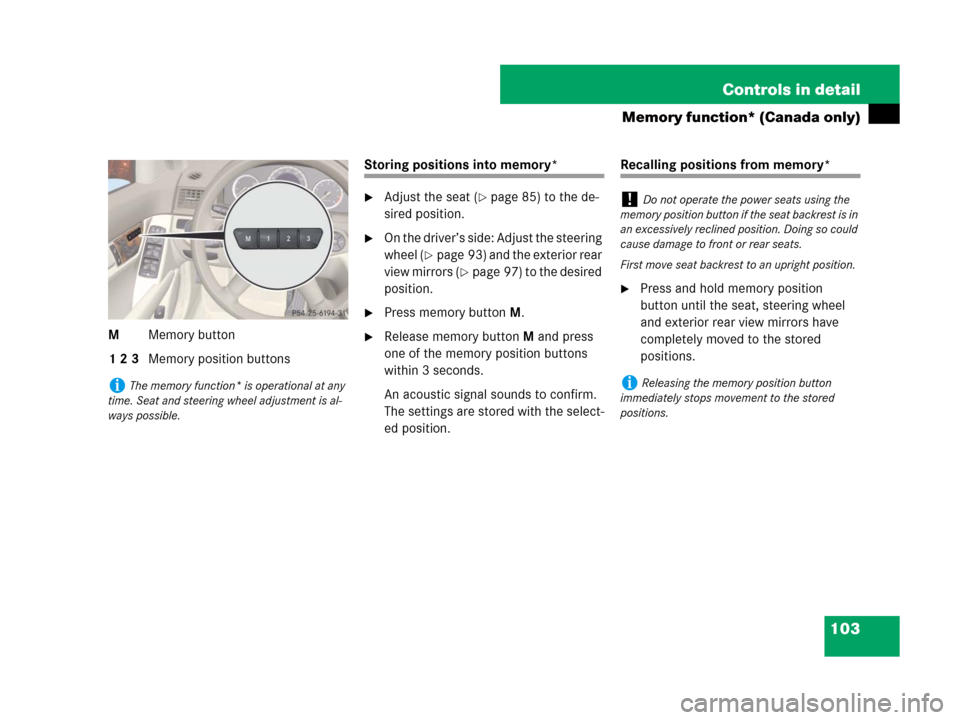
103 Controls in detail
Memory function* (Canada only)
MMemory button
1 2 3Memory position buttons
Storing positions into memory*
�Adjust the seat (�page 85) to the de-
sired position.
�On the driver’s side: Adjust the steering
wheel (
�page 93) and the exterior rear
view mirrors (
�page 97) to the desired
position.
�Press memory buttonM.
�Release memory buttonM and press
one of the memory position buttons
within 3 seconds.
An acoustic signal sounds to confirm.
The settings are stored with the select-
ed position.
Recalling positions from memory*
�Press and hold memory position
button until the seat, steering wheel
and exterior rear view mirrors have
completely moved to the stored
positions.
iThe memory function* is operational at any
time. Seat and steering wheel adjustment is al-
ways possible.
!Do not operate the power seats using the
memory position button if the seat backrest is in
an excessively reclined position. Doing so could
cause damage to front or rear seats.
First move seat backrest to an upright position.
iReleasing the memory position button
immediately stops movement to the stored
positions.
Page 107 of 509

106 Controls in detail
Fastening the seat belts
1Seat belt outlet
2Latch plate
3Release button
4Buckle
�Pull the seat belt smoothly from the
seat belt outlet1.
�Place the shoulder portion of the seat
belt across the top of your shoulder
and the lap portion across your hips.
�Push latch plate2 into buckle4 until
it clicks.
�If necessary, adjust the seat belt to the
correct height (
�page 107).
�If necessary, tighten the lap portion to
a snug fit by pulling shoulder portion
up.
�To release the seat belt, press release
button3 and guide latch plate2
back to seat belt outlet1.
Proper use of seat belts
�Do not twist the seat belt when fasten-
ing.
�Adjust seat belt so that the shoulder
portion is located as close as possible
to the middle of the shoulder (it should
not touch the neck). Never pass the
shoulder portion of the seat belt under
your arm.
�Position the lap belt as low as possible
on your hips (over hip joint) and not
across the abdomen.
�Place the seat backrest in a nearly up-
right position.
�Never use a seat belt for more than one
person at a time.
�Do not fasten a seat belt around a per-
son and another object at the same
time. When using a seat belt to secure
infant restraints or toddler restraints or
children in booster seats, always follow
the child seat manufacturer’s instruc-
tions.
Warning!G
Read and observe the additional warning no-
tices printed in the “Safety and Security”
section.